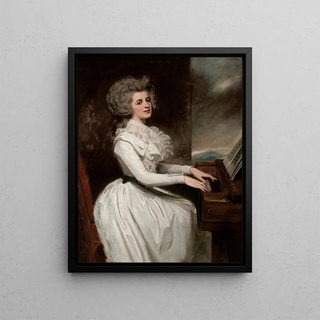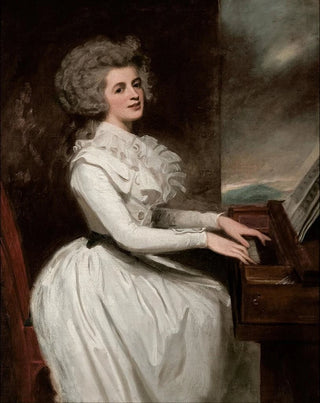Art print | Charlotte Mme Thomas Raikes - George Romney


View from behind

Frame (optional)
George Romney's artwork "Charlotte Mme Thomas Raikes" is a true immersion into the 18th century, a time when art and fashion intertwined with rare elegance. This portrait, which captures the very essence of feminine beauty of its era, transports us to a universe where every detail, every brushstroke, tells a story. The artist, renowned for his ability to grasp the nuances of his subjects' personalities, succeeds here in immortalizing Charlotte, wife of Thomas Raikes, in a way that evokes both delicacy and strength of character. The art print of this piece allows for a rediscovery of the timeless charm of classical painting while offering a glimpse into the social and cultural life of the period.
Style and uniqueness of the work
George Romney's style is distinguished by its refined and sensitive approach to portraits. In "Charlotte Mme Thomas Raikes," the chosen color palette evokes a softness that flatters the eye, while the carefully crafted composition confers a certain majesty to the subject. The drapery of Charlotte's dress, with its remarkable fluidity, seems almost alive, demonstrating Romney's talent for capturing movement and texture. The delicate features of the woman's face, illuminated by subtle light, reveal a psychological depth that goes beyond mere physical representation. This portrait aims to be a celebration of femininity, an ode to beauty that transcends time and continues to inspire art lovers.
The artist and his influence
George Romney, born in 1734, is one of the most emblematic painters of his era. Influenced by the great masters of the Renaissance, he developed a unique style that combines realism and idealization. His work has left a mark on the British artistic landscape, and he established himself as a preferred portraitist for the aristocracy of his time. Romney does not merely reproduce appearances; he seeks to capture the soul of his subjects, to reveal their character through the prism of art. His influence endures today, not only through his works but also through contemporary artists inspired by his approach to light and texture.

Matte finish

View from behind

Frame (optional)
George Romney's artwork "Charlotte Mme Thomas Raikes" is a true immersion into the 18th century, a time when art and fashion intertwined with rare elegance. This portrait, which captures the very essence of feminine beauty of its era, transports us to a universe where every detail, every brushstroke, tells a story. The artist, renowned for his ability to grasp the nuances of his subjects' personalities, succeeds here in immortalizing Charlotte, wife of Thomas Raikes, in a way that evokes both delicacy and strength of character. The art print of this piece allows for a rediscovery of the timeless charm of classical painting while offering a glimpse into the social and cultural life of the period.
Style and uniqueness of the work
George Romney's style is distinguished by its refined and sensitive approach to portraits. In "Charlotte Mme Thomas Raikes," the chosen color palette evokes a softness that flatters the eye, while the carefully crafted composition confers a certain majesty to the subject. The drapery of Charlotte's dress, with its remarkable fluidity, seems almost alive, demonstrating Romney's talent for capturing movement and texture. The delicate features of the woman's face, illuminated by subtle light, reveal a psychological depth that goes beyond mere physical representation. This portrait aims to be a celebration of femininity, an ode to beauty that transcends time and continues to inspire art lovers.
The artist and his influence
George Romney, born in 1734, is one of the most emblematic painters of his era. Influenced by the great masters of the Renaissance, he developed a unique style that combines realism and idealization. His work has left a mark on the British artistic landscape, and he established himself as a preferred portraitist for the aristocracy of his time. Romney does not merely reproduce appearances; he seeks to capture the soul of his subjects, to reveal their character through the prism of art. His influence endures today, not only through his works but also through contemporary artists inspired by his approach to light and texture.






